



Livestock Price and Profitability Outlook
The holiday season is fast coming, marking the end of a year of variable livestock and feed prices.Profitability has improved from the past two years, but very profitable returns in the spring and early summer have turned to near breakeven in the past four months. Figure 1 graphs the estimated returns to the finishing yearling steers in Iowa over the past several years. Most of the decline in profitability has been the result of rising feed costs and substantially higher feeder cattle prices over the summer months. Demand for feeder cattle in a short supply marketplace lead cattle buyers to bid away much of their potential profit margins. Then corn prices started to steadily increase through the late summer and fall. For the past four months, cattle returns have been near or slightly below breakeven. Current fed cattle prices and feed costs will keep cattle returns very near breakeven for the remainder of the year.
Figure 1. Iowa Estimated Returns to Yearling Finishing

For the past year, ISU extension has been producing a weekly “crush” margin for cattle and hog finishing. Figure 2 tracks the cattle crush margins over the past year for cattle that will be marketed in the next five months. The crush margin for cattle currently on feed assumes that the corn price is pegged at the cash price the month the feeder animal was purchased and place on feed. For example, the crush margin for cattle to be marketed in December are currently at the over $200/hd. If a $150 crush margin is needed to breakeven, then a hedge on hedge on fed cattle will deliver a return of over $50/hd. For cattle to be marketed in March, the crush margin is near $250/hd, or $100 profit per head if a hedge were placed at the current April live cattle futures contract price. More information pertaining to cattle crush margins is available at www.econ.iastate.edu along with hedge crush margins available for cattle to be marketed in the next 16 months. In the nearby, the margins are improving as the fed cattle futures have been improving. Producers who are planning to market in the next five months, should watch the futures market closely. Futures prices for live cattle in the spring are well over $1/pound. If the futures price is correct and cash price rises to those levels, the industry will be seeing some record high spring prices. Producers should consider the questions ‘what are the chances of the futures price improving’ and ‘what are the chances that the futures is over predicting the market’? While the market fundamentals are strong, the cash market price is probably not going to reach $110/cwt, however a second downturn in the economy could send fed cash prices below $100/cwt. Producer will be keeping a close eye on the futures market movement into the beginning of the new year.
Figure 2. Crush Margin Hedges for Yearlings in Yard

Hog prices were very weak in October and Figure 3 illustrates the slippery slope prices were on during October. Cash hog prices have since started to recover, but are still in the mid-$60s/cwt. The reason for such a quick decline in cash prices is seen in the hog slaughter numbers in Figure 4. The industry has a hog slaughter capacity threshold of about 2.2 million head of hogs per week. The number of hogs coming to market in October even surpassed 2009 levels at well over 2.3 million head. This extra wave of hogs led packers to drop purchase prices. Hog supplies took an unexpected jump due in large part to the animal response to new crop corn. Reports are that hogs are eating the new crop very readily and gaining at a faster rate than expected. This has pushed hog marketing dates forward and stacked up delivery during October. As the supply of market ready hogs starts to smooth out and returns to previously expected levels, prices will slowly improve through the end of the year. The outlook for the next two quarters is one of steadily improving prices. The price recovery will be steady until the middle of 2011, with hog prices in the middle or even upper $80/cwt. Margins have become tighter but for the most part are still profitable for hog producers through the end of summer 2011. Feed costs have been a major factor in reduced projected gross or “crush” margins for swine finishers in the next eight to nine months. With the current demand, cash corn prices are expected to climb into the summer months. Producers should consider their current profit opportunities with a margin protection strategy.
Figure 3. Iowa-So. Minn. Barrow and Gilt Prices
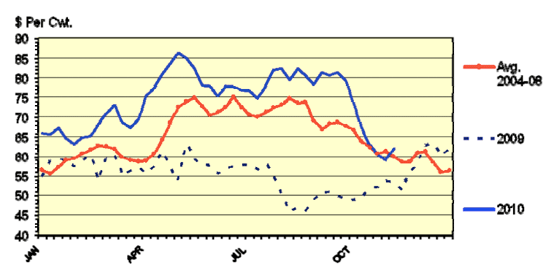
Figure 3. Iowa-So. Minn. Barrow and Gilt Prices

What a difference a year makes. Last year, we were dealing with snow on the ground in October and late maturing crops. This year, we have barely seen any precipitation during harvest and the crops matured early. Figure 1 shows harvest progress for U.S. corn and soybeans (as of Oct. 24) and compares this year’s progress with previous years. As the graphs show, the 2010 harvest in the U.S. is the one of the fastest of the past 30 years. In comparison, the 2009 harvest was one of the slowest on record. Delays in harvest supported crop prices last fall. The quick harvest this fall has put downward pressure on prices, but that impact has been overwhelmed by other factors.
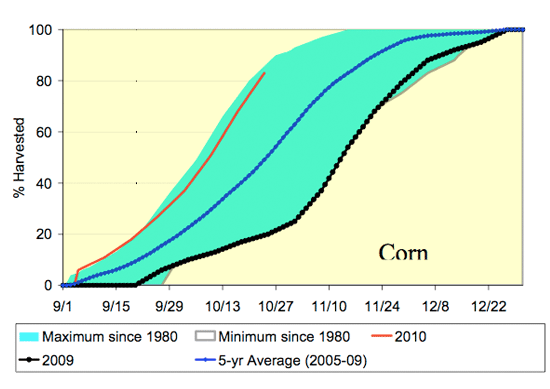
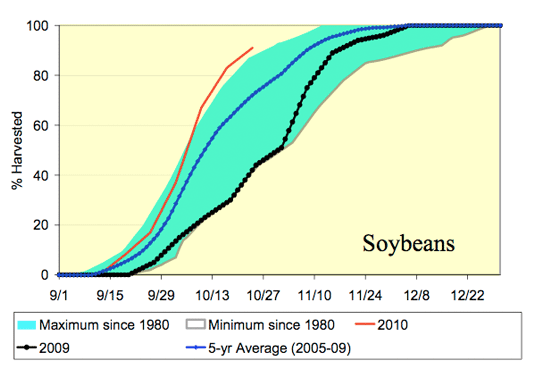
The big story on the production side is the decline in corn production. In August, USDA had estimated national corn yields at 165 bushels per acre, which would have set a record. In October, USDA lowered their estimate to 155.8 bushels per acre. The 9.2 bushel drop pulled 700 million bushels out of production and that has sent the markets significantly higher. In looking at the objective yield data USDA uses to compute their yield estimates, there is a combination of shifts that drove the yield decline. First, USDA found fewer ears per acre in October than they had counted in August. But the bigger shift occurred in grain weights. Based on the early progress of the corn crop this year, USDA crop models had estimated grain weights on the order of 0.35 pounds per ear. That is a little bit higher than last year and significantly above we had from 2005 to 2008. With the warmer night-time temperatures we experienced this year and problems with nitrogen deficiency, the grain fill period for corn was shortened. And in October, USDA found grain weights near 0.335 pounds per ear. That doesn’t sound like much of a drop, but multiply it over 88 million acres of corn and the impact is roughly 700 million bushels.
Soybeans, on the other hand, are projected to set production records. 2010 acreage was a record 77.7 million acres. National yields are projected at a record 44.4 bushels per acre. So, production is set to top 3.4 billion bushels of soybeans for the 1st time. Record yields are projected for North Dakota, Nebraska, Minnesota, Wisconsin, Illinois, New York, and Louisiana. Sudden death syndrome impacted individual farms, but seems to have had little impact on national soybean production. As it stands in 2010, the U.S. will have produced its 3rd
largest corn crop and largest soybean crop. But as recent market prices have shown, these big crops aren’t that big in comparison to the demand for them. You know demand is strong when a 12.6 billion bushel corn crop is considered short.
Crop demands are up with global economic recovery. Corn demand via ethanol was raised again for the 2009 crop, to 4.56 billion bushels. The outlook for the 2010 crop is for 4.7 billion bushels to head to ethanol facilities. Crude oil prices have been hovering in the $80 per barrel range and this has helped ethanol margins remain positive over the several few months. Figure 2 shows ethanol blending margins from January 2007 through October 2010. These margins show that ethanol blending has been economically worthwhile for the vast majority of time over the past four years. The only time ethanol blending did not make economic sense was around New Year’s 2009 when ethanol prices were significantly above gasoline prices. The ethanol tax credit is worth 4.5 cents per gallon of E10. As the graph shows, ethanol blending margins have exceeded the tax credit most of the time. But the recent run-up in corn and ethanol prices has tightened ethanol blending margins. The 2011 calendar year holds a couple of wildcards for ethanol demand, as E15 is introduced to the general public and the ethanol tax credit may be allowed to expire. The E15 shift should reduce “blend wall” issues for a while, but the possible loss of the tax credit could put a damper on the industry.
Figure 2. Ethanol Blending Margins
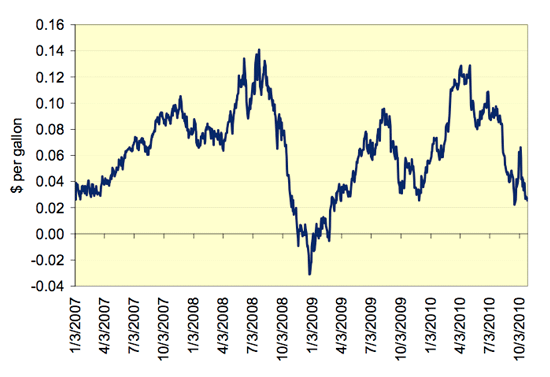
Corn feed and residual demand for the 2010 crop is projected at 5.4 billion bushels, up sizably from the last couple of years. Feed demand had been in decline with the financial difficulties the livestock industry has faced in 2008 and 2009. But returns to the livestock industry have been on the mend over the last year. Livestock margins have been at or above breakeven for the last several months and are expected to remain around breakeven for a few more. But the outlook for summer 2011 is for the margins to fall below breakeven. So while feed demand is still the largest demand category, it remains the demand category with the weakest outlook.
Corn export demand is estimated at 2 billion bushels, up slightly from last year, continuing a recovery from the recession. Weakness in the dollar supports the export outlook. Figure 3 displays export sales so far this marketing year. Current corn export sales pace is just ahead of last year, but has been slower than the trade has expected. Exports remain the big story for soybeans, especially exports to China. USDA increased its export estimate to 1.52 billion bushels. This would top last year’s record. And the early sales pace supports those projections. As of mid-October, sales to China are up 14%, sales to Mexico are up 34%, and sales to Indonesia are up a whopping 239%. Worldwide demand for Iowa crops remains strong.
Domestic crush demand is projected at 1.665 billion bushels, down nearly 100 million from last year. USDA projections have domestic use of soybean meal and oil on the increase, while export demand is expected to fall. However, given the strong export demand for raw soybeans, I expect export demand for soybean meal and oil to remain strong as well. Biodiesel demand for soybean oil will be a key variable to watch in 2011. The industry is still reeling from the loss of its tax credit. But the Renewable Fuels Standard should provide some support to biodiesel for the next couple of years as the standard calls for increasing amounts of biodiesel. By 2012, one billion gallons of biodiesel is needed to meet the standard.
Figure 3. Export Sales through Oct. 14
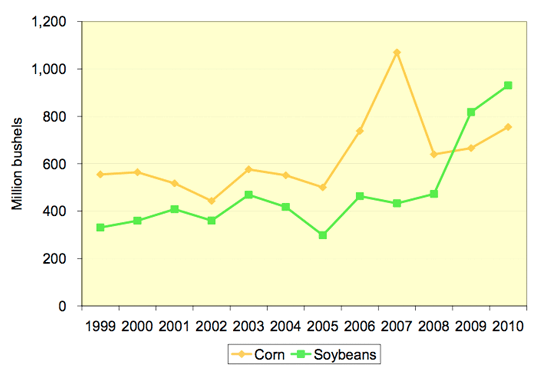
From their early October outlook, USDA had projected ending stocks for corn at 902 million bushels, over 800 million bushels less than last year. That implies a stocks-to-use ratio of 6.7%, the tightest we have seen since 1995. Soybean ending stocks were estimated at 265 million bushels, up 114 million bushels from last year. The increase in soybean stocks is large, but stocks still remain below historical averages. Season-average prices were projected at $5.00 for corn and $10.75 for soybeans. The futures markets have already raced past those levels
though. Current futures prices (as of the end of October) point to season-average prices around $5.45 per bushel for corn and $11.75 per bushel for soybeans. The higher prices we are seeing today will likely be with us for some time.
As it stands right now, the 2010 crop year looks to be a profitable one for Iowa corn and soybeans. With cash prices above $5 per bushel for corn and $11 per bushel for soybeans, there are strong marketing opportunities currently. And futures are showing strong marketing opportunities for both crops in the future as well. As producers prepare for the 2011 growing season, they should take a little time, analyze their production costs, and take advantage of marketing opportunities that cover those costs and offer additional returns. Pre-harvest marketing of some (not all) of your expected crop usually pays off and this looks to be the case for 2011.


